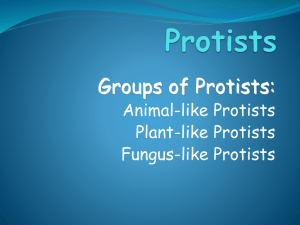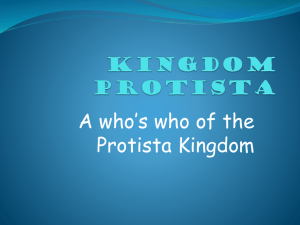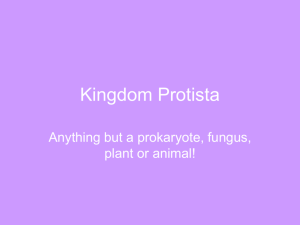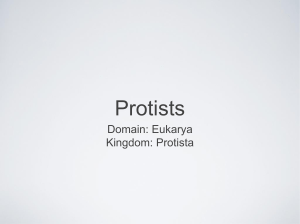Protists Three Groups of Protists: Animal-like Protists Plant-like Protists
advertisement
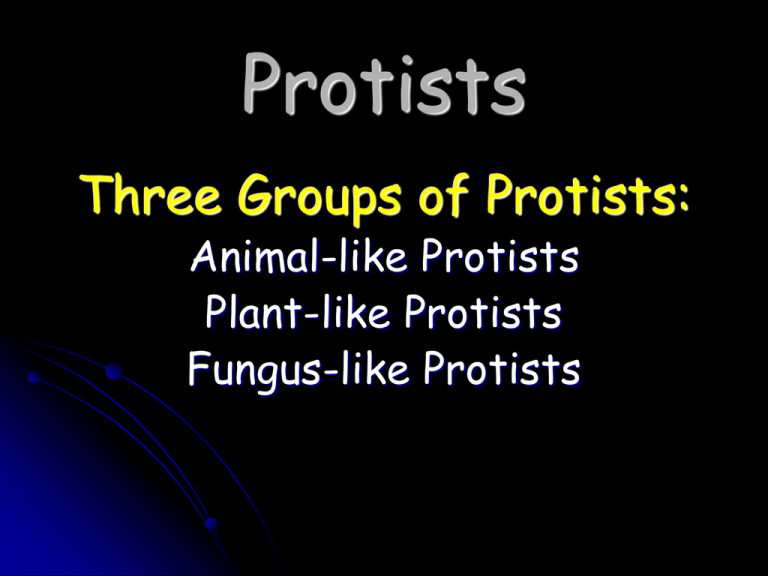
Protists Three Groups of Protists: Animal-like Protists Plant-like Protists Fungus-like Protists Protist Diversity 200,000 species: different shapes, sizes, and colors All eukaryotes – have a nucleus and membrane-bound organelles Not bacteria, animals, plants, fungi (the organism junk drawer) Reproduce asexually or sexually Protists are the most diverse of all eukaryotes. Asexual reproduction Binary fission Sexual reproduction Conjucation Animal-like Protists “Protozoa” Protozoans Unicellular –one cell Heterotrophs – they eat other organisms or dead organic matter Classified by how they move Phyla of Protozoans Phylum Zoomastigina “Zooflagellates” (giardia) Phylum Sarcodina“Sarcodines” (amoeba) Phylum Ciliophora “Ciliates” (paramecium) Phylum Sporozoa “Sporazoans” (plasmodidium) Sarcodines – move by extensions of their cytoplasm. Ciliates – move by means of cilia. Sporozoans – do not move on their own. Amoebas: the blobs No cell wall Move using pseudopods – plasma extensions Engulf bits of food by flowing around and over them Amoeba Pseudopods Found in freshwater Moves using pseudopods- “false feet”cytoplasmic projections They also use pseudopods for feeding Amoeba Pseudopod Paramecium Pseudopod Food Vacuole More amoebas Amoebic dysentery Entamoeba histolytica Amoebas feed on intestinal lining, causing bloody diarrhea. Contaminated food or water. Flagellates: the motorboats Use a whip-like extension called a flagella to move Some cause diseases Giardiasis – Giardia lamblia Cramps, nausea, diarrhea, and vomiting Contaminated water Leishmaniasis – Trypanosoma Skin sores and deep, eroding lesions. Bites from sand flies. Trichomonas foetus : cow disease Trichomonas vaginalis: an STD Ciliates: the hairy ones Move beating tiny hairs called cilia Paramecium- move using cilia (tiny hairlike projections) Paramecium reproduction Sporazoans: the parasite Non-motile - Do not move Live inside a host One type causes malaria Malaria in red blood cells MALARIA – Plasmodium Causes severe chills, fever, sweating, confusion, and great thirst. Spread from person to person by the anopheles mosquito. Plant-like Protists “Algae” The Unicellular Plant-Like Protists What are Algae? Unicellular – made of one cell Multicellular – made of more than one cell Photosynthetic – make their own food No roots, stems, or leaves Each has chlorophyll and other photosynthetic pigments Red algeal bloom Brown Algea: Giant Kelp Forest Volvox: a green colonial algae Phyla of Unicellular Algae Phylum Euglenophyta (euglena) Phylum Chrysophyta (golden algae) Phylum Bacillariophyta (diatoms) Phylum Pyrrophyta (dinoflagellates) Euglenoids: Aquatic Move around like animals Can ingest food from surroundings when light is not available Euglena Euglena contain: chloroplasts, a flagella, and an eyespot to sense where light is. Unique because they are both heterotrophic and autotrophic. Diatoms: The Golden Ones Have shells made of silica (glass) Photosynthetic pigment called carotenoids – give them a golden color Dinoflagellates: The Spinning Ones Spin around using two flagella Responsible for Red Tides Create toxins that can kill animals and sometimes people Algal Blooms High temps and increase in nutrients (nitrates and phosphates) lead to increased algae populations Harmful to fish and humans (red tide) Swimming with Bioluminescent Dinoflagellates Plant-like Protists “Algae” The Multicellular Plant-like Protists All are autotrophic-meaning they can make their own food Examples: Euglena Algae Phyla of Multicellular Algae Phylum Rhodophyta (Red Algae) Phylum Phaeophyta (Brown Algae) Phylum Chlorohyta (Green Algae) Red Algae: Seaweeds Multicellular, marine organisms Have red and blue pigments Brown Algae: They have air bladders to help them float at the surface – where the light is. Green Algae: Most live in fresh water Can be unicellular or multicellular Live alone or in groups called colonies Green Algae: Unicellular Colonial – Chalamydomonas Algae – spyrogyra, volvox Multicelluar - Ulva Conjugation of Spyrogyra The life cycle of Chlamydomonas “cloning” – plants identical to each other Isogamy = male and female gamete identical in size Sexual reproductioncreate variation Fungus-like Protists Fungus-Like Protists Fungus-like Protists All form delicate, netlike structures on the surface of their food source Obtain energy by decomposing organic material Phyla of Fungus-like Protists Phylum Acrasiomycota - Cellular Slime Molds Phylum Myxomycota - Plasmodium Slime Molds Phylum Oomycota - Water Molds & Downy Mildews Slime Molds Live in cool moist, shady places where they grow on damp, organic matter Plasmodium Slime Molds Form plasmodium: a mass of cytoplasm that contains many diploid nuclei but no cell walls or membranes – its feeding stage Creeps by amoeboid movement – 2.5 cm/hour Plasmodium continued… May reach more than a meter in diameter Form reproductive structures when surroundings dry up Spores are dispersed by the wind and grow into new plasmodium Cellular Slime Molds In feeding mode, they exist as individual amoebic cells When food becomes scarce, they come together with thousands of their own kind to reproduce May look like a plasmodium Slime molds upclose Water and Slime molds are not in the Kingdom Fungi because their cell walls are made up of cellulose not chitin. Figure 27.32 A Cellular Slime Mold Figure 27.14 Alternation of Generations The standard or beginning model Water Molds and Downy Mildews Live in water or moist places Feed on dead organisms or parasitize plants Fuzzy white growths Water molds: Water molds: Completely aquatic Often decomposers Sometimes parasitic Water mold attacking a fish
